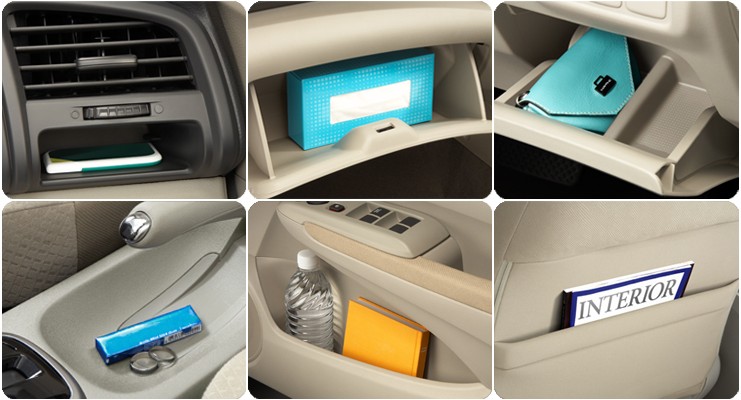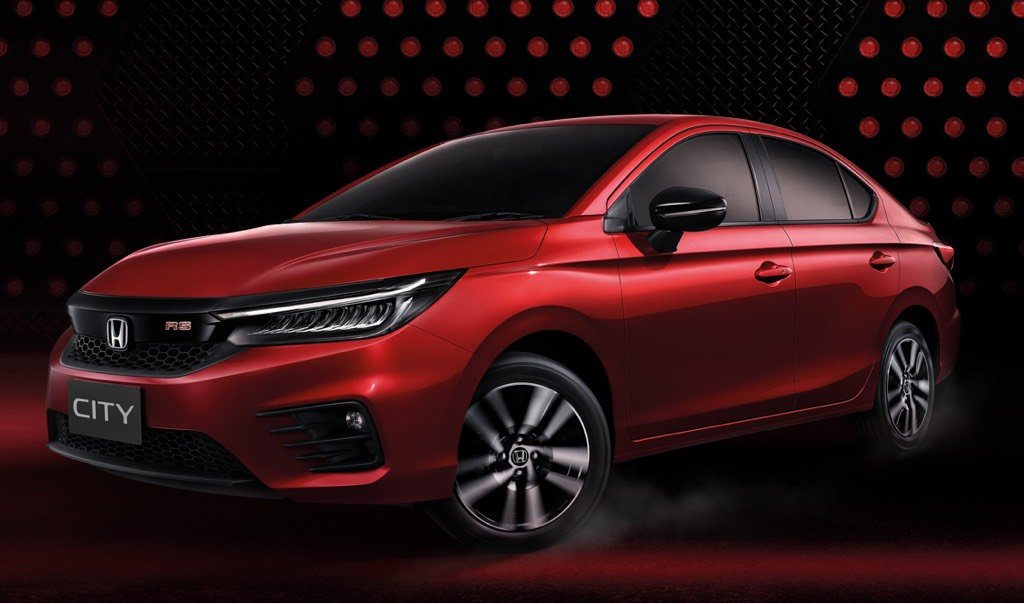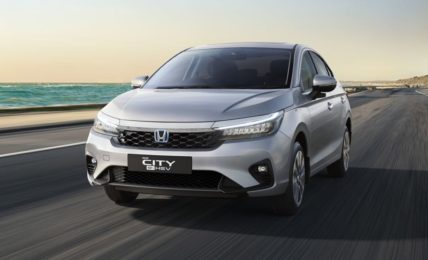Text – Faisal Khan; Pictures – Om Vaikul
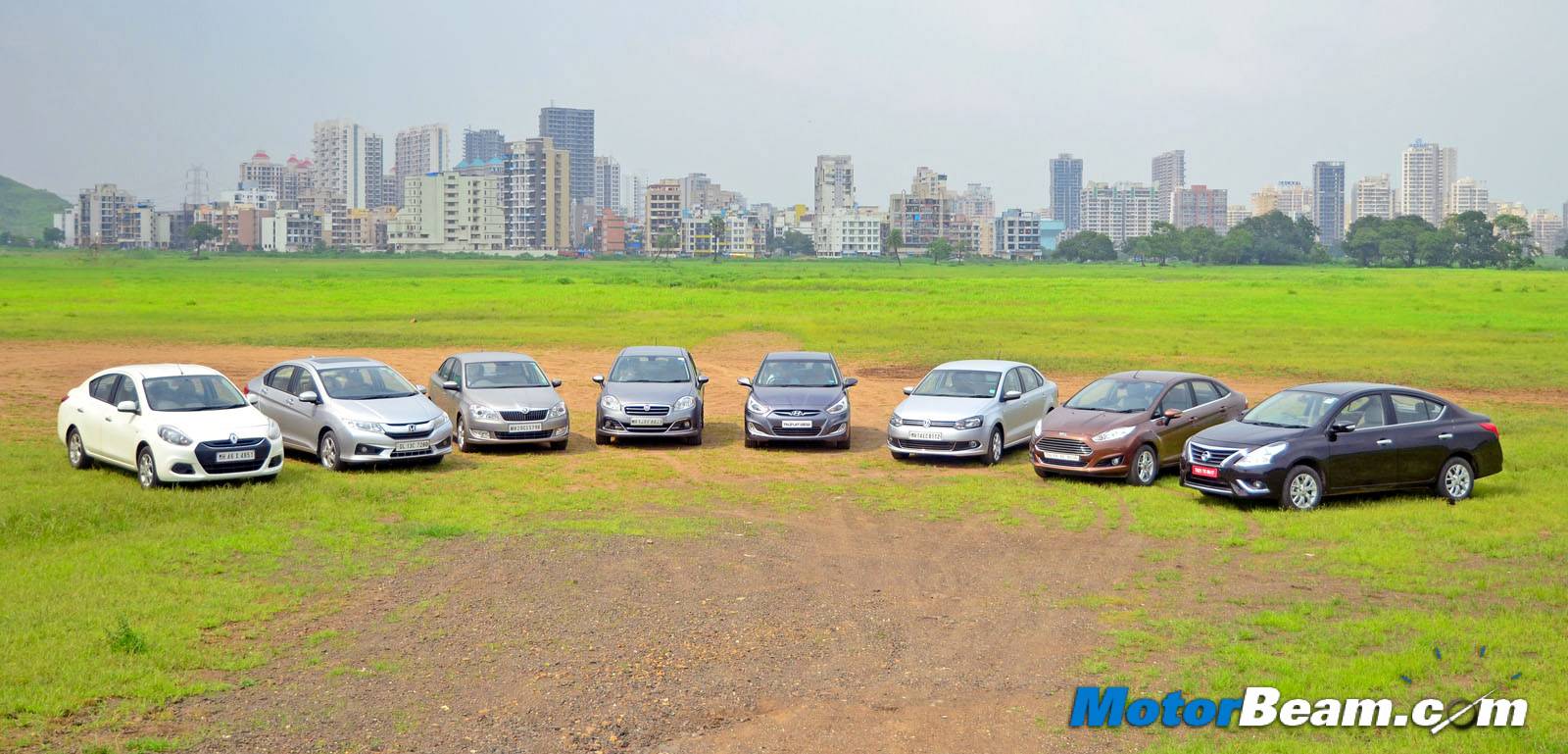
Price OTR Mumbai: Rs. 8.21-11.50 lakhs (Fiat Linea), Rs. 8.28-11.41 lakhs (Skoda Rapid), Rs. 8.31-11.94 lakhs (Nissan Sunny), Rs. 8.45-11.89 lakhs (Renault Scala), Rs. 8.50-14 lakhs (Hyundai Verna), Rs. 8.54-13.39 lakhs (Honda City), Rs. 8.71-12.06 lakhs (Volkswagen Vento), Rs. 9.39-11.33 lakhs (Ford Fiesta)
The C-segment is where the battle between automakers in India is by far the most intense
The C-segment is the most interesting segment in India because it’s the only segment which has so many cars on offer, there is something for everyone here. In fact, the Honda City and Hyundai Verna are the biggest sellers in this segment and the other cars aren’t even looked at which is a shame because all of these eighth vehicles are really good in their own way. With more cars stepping in, confusion is always at the peak for a prospective buyer. Which car should one buy? There are cars from almost every brand to confuse you. In fact, the C-segment is so big that except Toyota, everyone global car maker is here to pluck a small pie of the market. In usual MotorBeam style, we are here to clear all confusion once for all by pitting all these eight cars head to head, yes, this is the biggest C-segment car comparison you would ever come across. Does the City shine bright on the top or do the Fiesta, Linea, Vento show that they are the real king when it comes to product engineering? Does value for money offerings like the Sunny, Scala, Rapid and Verna shake anyone? We have a definite answer in this shootout.
Motor Quest: The Honda City has long been the leader of the C-segment and has remained almost unchallenged in its long innings in India. The only time the City was displaced from the top was when demand for diesel cars surged high and Honda did not have a diesel version of the City, the Hyundai Verna became the segment king then. As soon as the fourth generation City was launched, the Verna was immediately displaced from the top. Meanwhile all the other six cars don’t sell even close to how much the City sells, in fact, all the seven cars combined don’t match the City’s sales numbers.
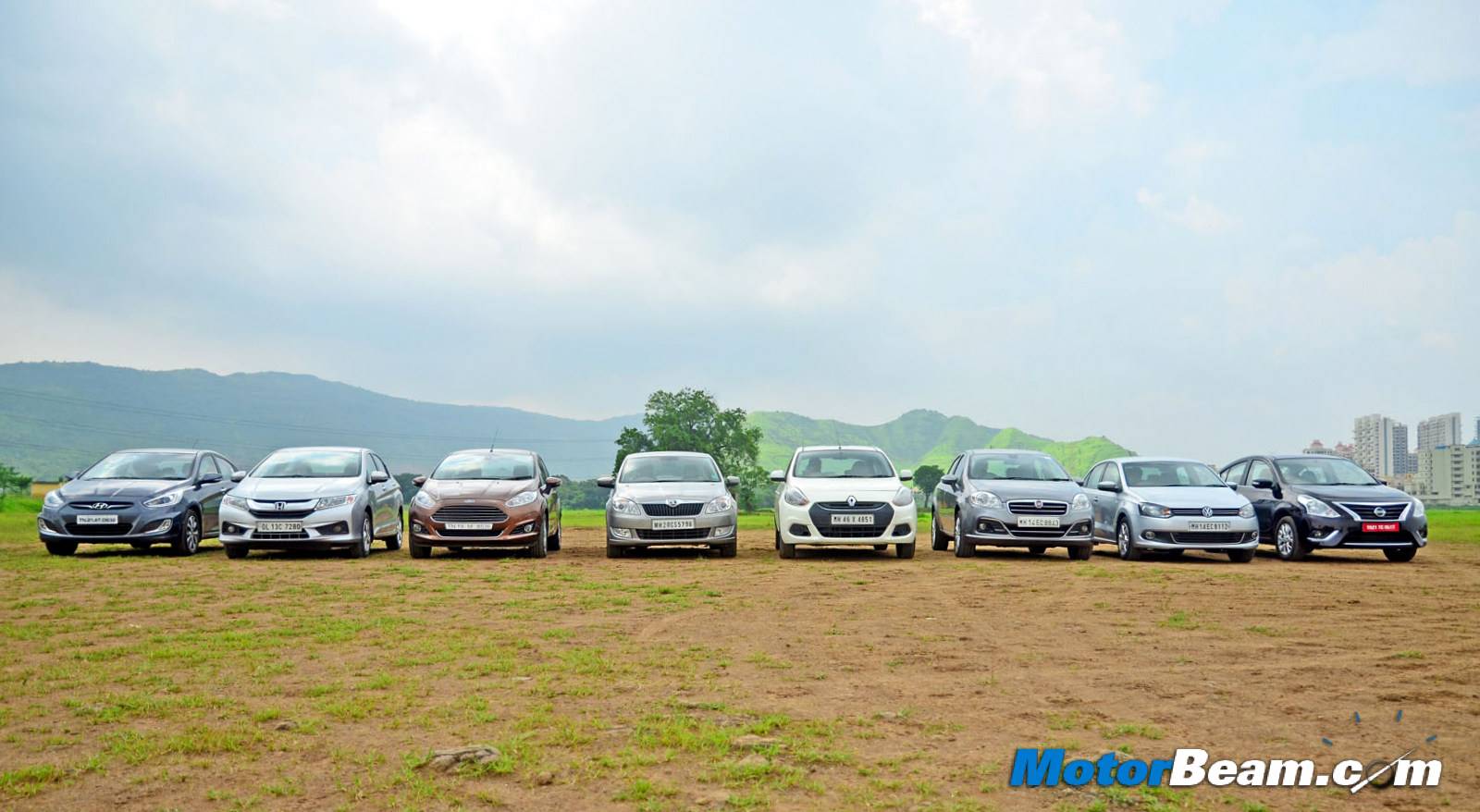
Styling – All eight cars parked together, we did a quick walk around and needless to say, it was the Ford Fiesta which really made us pause and stare. The second most attractive vehicle here is without a doubt the Fiat Linea, another car where style is flowing in abundance. Ranking someone third would be a tough call, one side is Hyundai’s Verna which really looks swell with the fluidic design language while on the other is the Vento with classic Volkswagen style cues. The City comes fifth and it’s a car which doesn’t really inspire you to stop and stare because the styling is similar to the outgoing model although every body panel has been changed. The rear styling is a bit of a hit and miss too.
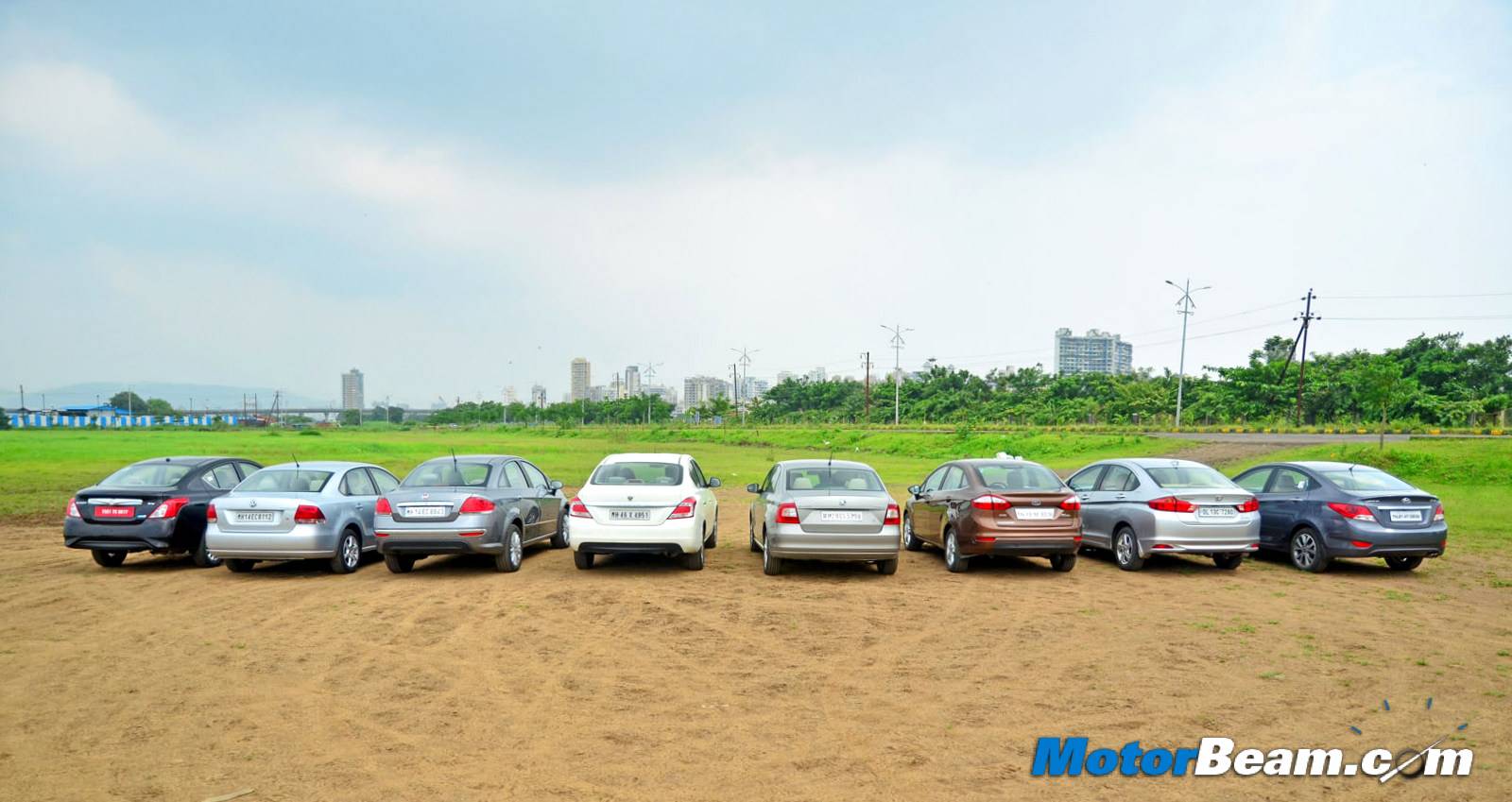
Finishing last are the Nissan Sunny, Renault Scala and Skoda Rapid, three cars which don’t look striking at all. To Nissan’s credit, the Sunny was recently facelifted so it does look a bit fresh compared to its doppelgänger, the Scala. Both the Sunny and Scala use a lot of chrome (the City and Linea aren’t far behind in this regard either) which is sure to go down well with people who like a bit of glitter on their cars. The Rapid might have Skoda design cues but it looks dated and that Fabia inspired front end just doesn’t cut it for us anymore. Back to the best, the Fiesta’s Aston Martin inspired front-end is so striking that a few people without much knowledge asked us if this was a Maserati.
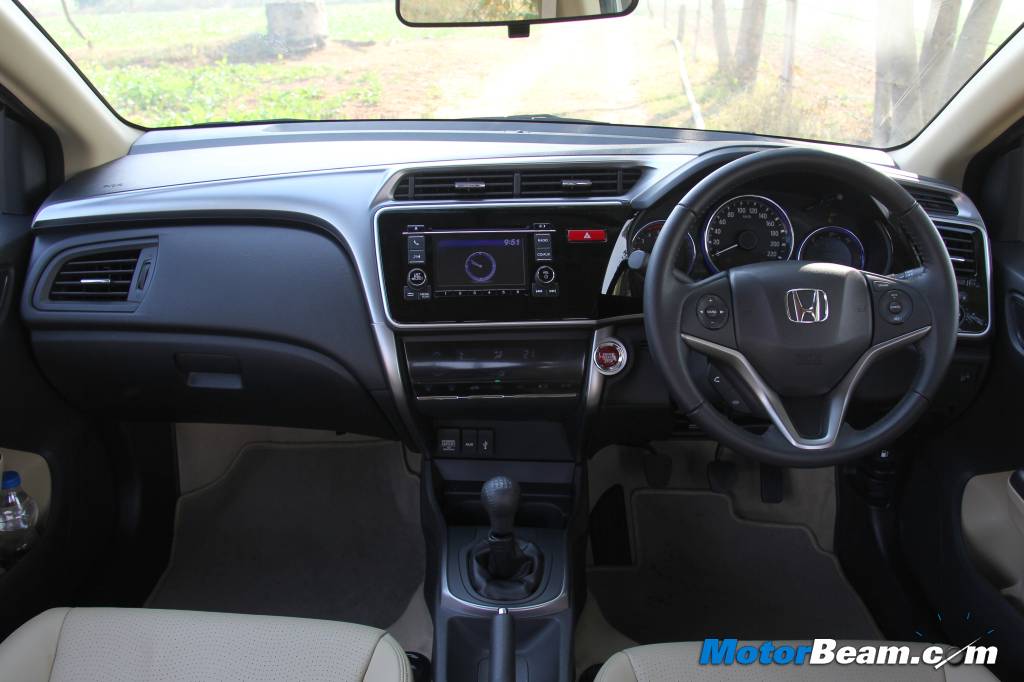
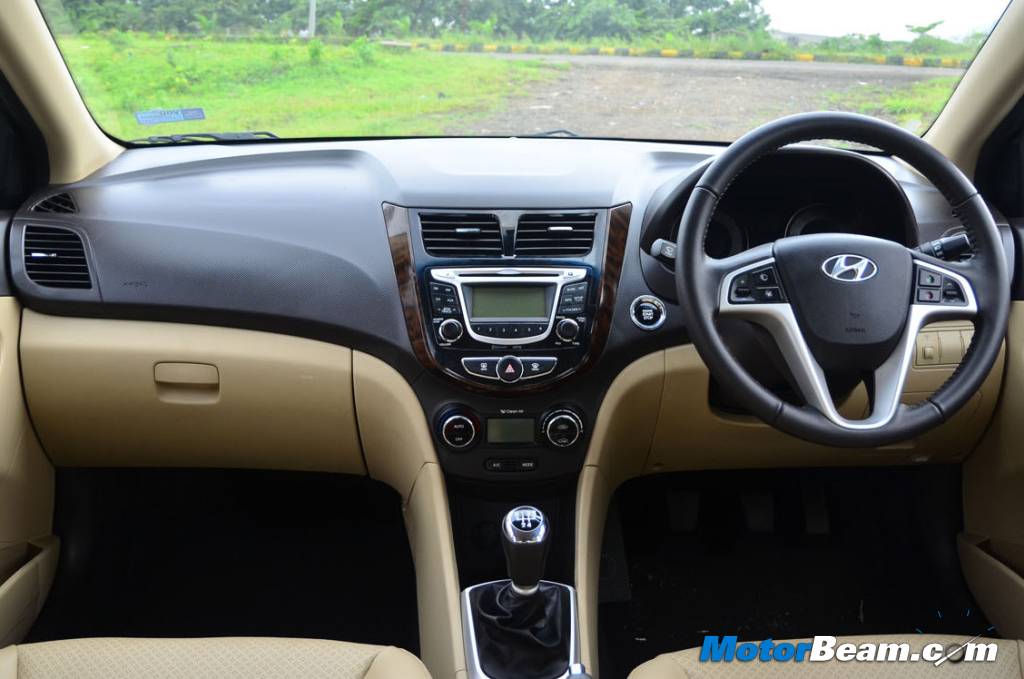
The Honda City and Hyundai Verna have the best interiors here, both these cars have the most features too
Interiors – The top-end variants of all these cars cost upwards of 1 million rupees and thus quality hasn’t been compromised on. All these vehicles have good quality interiors but the best quality is seen in the Hyundai Verna whose interior design only comes a close second to the City’s. The Fiat Linea has the best build here, sharing the honours with the Ford Fiesta, both of these cars feeling like a tank. The Rapid and Vento siblings are quite similar with a very classic dashboard design but they fail to make an impression in front of the City’s funky layout. The other siblings here are the Sunny and Scala, the Nissan having a much better interior as the Scala continues to use the old Sunny’s dashboard which was a bit boring. The 3-spoke steering and piano black inserts really do uplift the cabin of the Sunny but still it’s a very mature design with not much excitement injected into it.
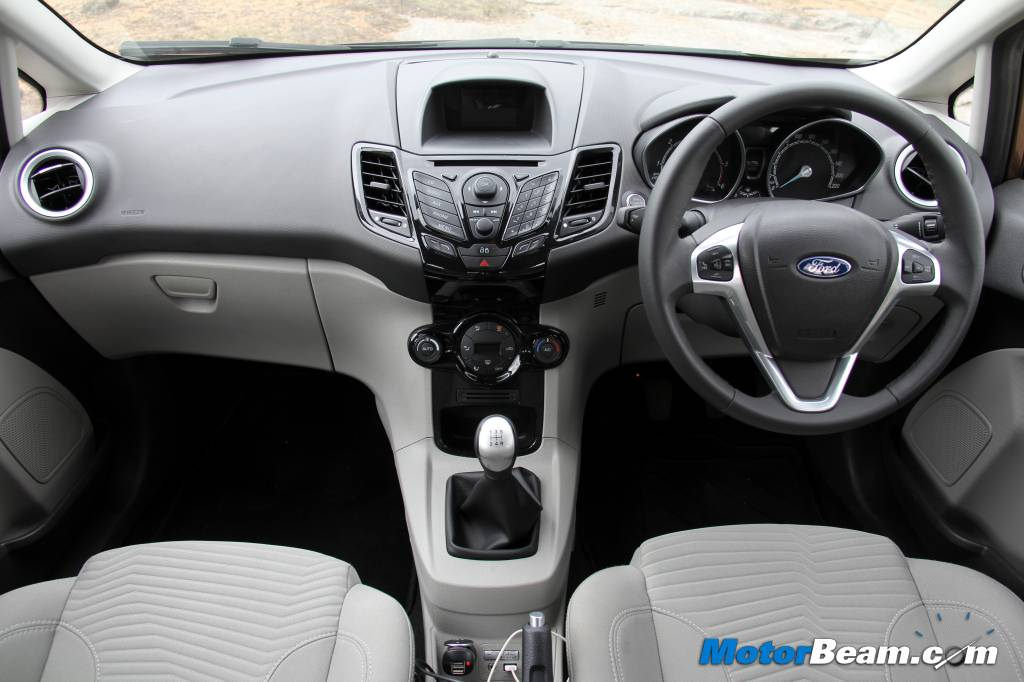
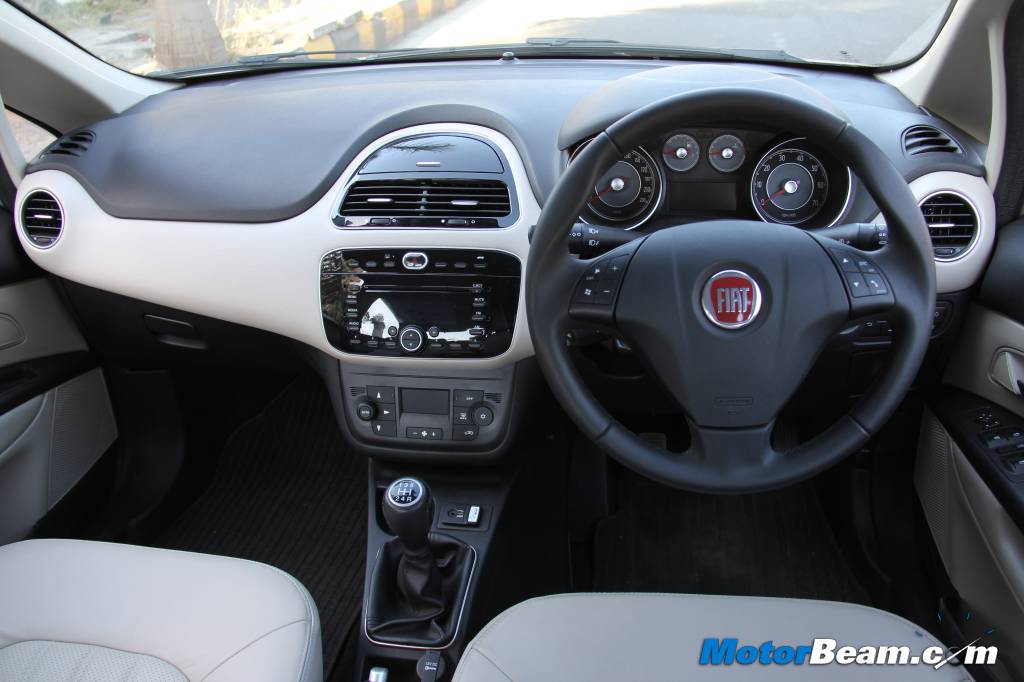
The Linea and Fiesta have a funky cabin but both lack heavily on interior space compared to the competition
If you are going to buy a C-segment car then there is quite a chance that you would end up sitting at the rear bench and in that aspect, nothing beats the Sunny and Scala. The Sunny being the fresher vehicle with more features on-board, trumps its carbon copy from France to sit on the top when it comes to interior space and comfort. Both the Renault-Nissan cars might appear the longest here but it’s shocking to note that the City is actually longer, the Honda able to come close in offering a load of rear seat space. What makes the City the best car in terms of rear seat experience are the fantastic seats, it just has the best seats among the eight cars with no one matching it even close. It’s only the Fiesta (car with the least length here) and Verna which lack rear AC vents, the Scala and Sunny doing with merely a rear fan.
The Sunny has the most space, Verna has the best quality while the City has a good blend of both
The longest car here is the Fiat Linea but it can’t match the Sunny, Scala and City in terms of rear seat space. In fact, even the Vento, Rapid and Verna beat it on that regard. The Fiesta has the worst rear seat legroom and that makes it a car best enjoyed by people who like to sit at the front and leave the rear to children. The Vento and Rapid beat the Verna in rear seat comfort but the Hyundai has a ton of features on offer, the VW siblings being no match for the Korean in terms of equipment. In fact, the only car which matches the Verna in terms of features is the Honda City. The City has almost all the features of the Verna with a segment first sunroof also on offer while the Verna has side airbags, the most of any car here, the Sunny being second with four airbags. All other cars come with standard dual front airbags with driver side airbag being standard on almost all variants of these cars (the Vento being the only car with airbag only on the top-end variant which is shocking as the Polo gets dual airbags on all variants). Most of these vehicles have similar levels of equipment with small things to differentiate it.
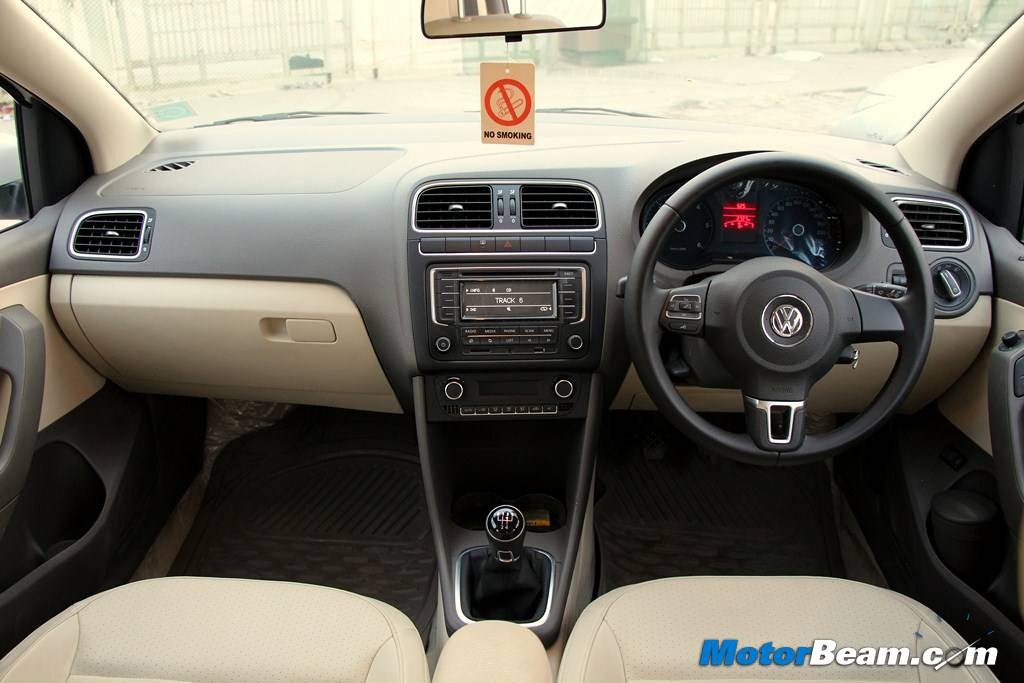
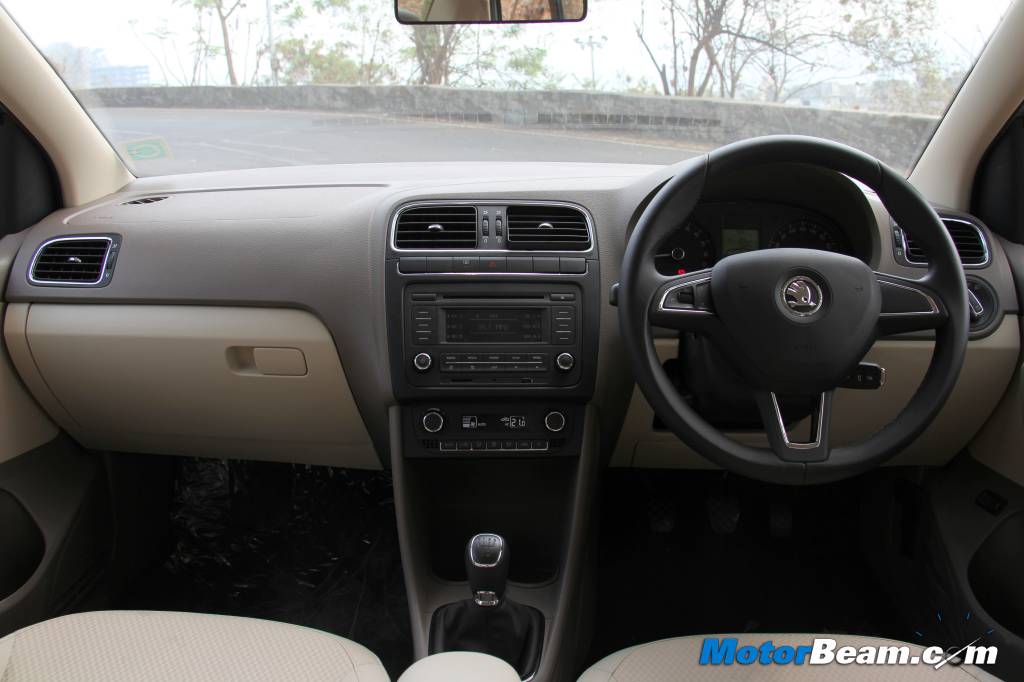
Classic design cues on the inside of the Vento and Rapid work well, the cars feel very solid like the Linea
For instance, all cars come with Bluetooth connectivity, the one on the Linea doesn’t stream music and the Fiat’s system is the most complicated to pair and use. The Fiesta is the only car with Ford AppLink and voice commands, a feature which is super cool and useful too. Except the Vento, Rapid and Linea (they get flip keys), all cars come with keyless entry (the City also has a sensor so you don’t need to press a button on the door handle) with push button start. Steering mounted audio controls and climate control are also standard on all these vehicles. The Sunny, City and Verna are the only cars to come with a rear view camera while most of these vehicles get reverse parking sensors (none on the Rapid and Scala).
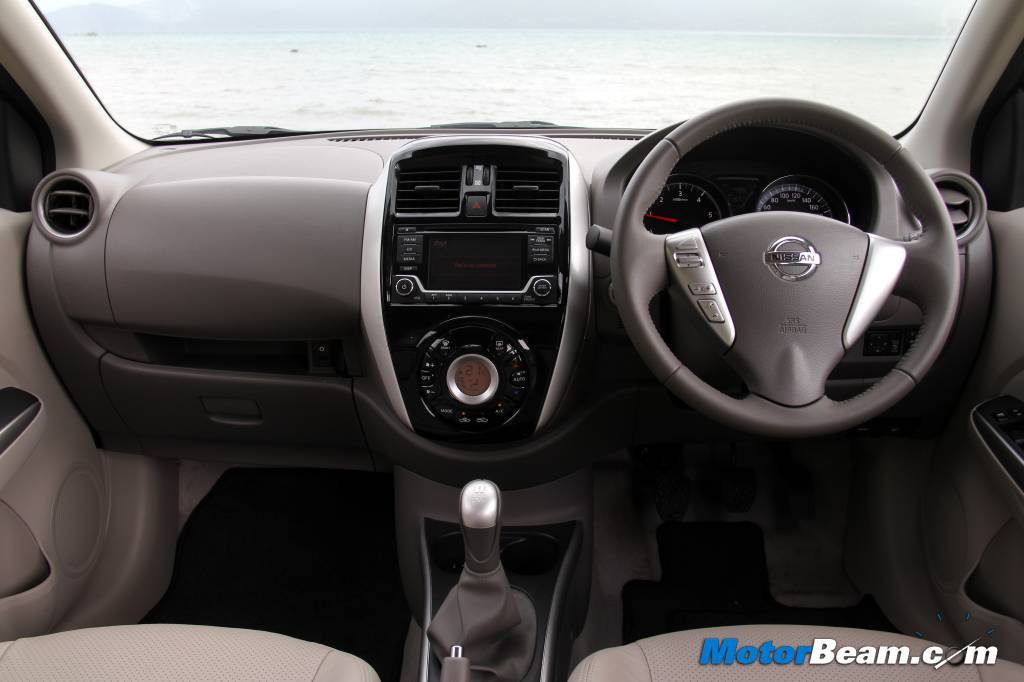
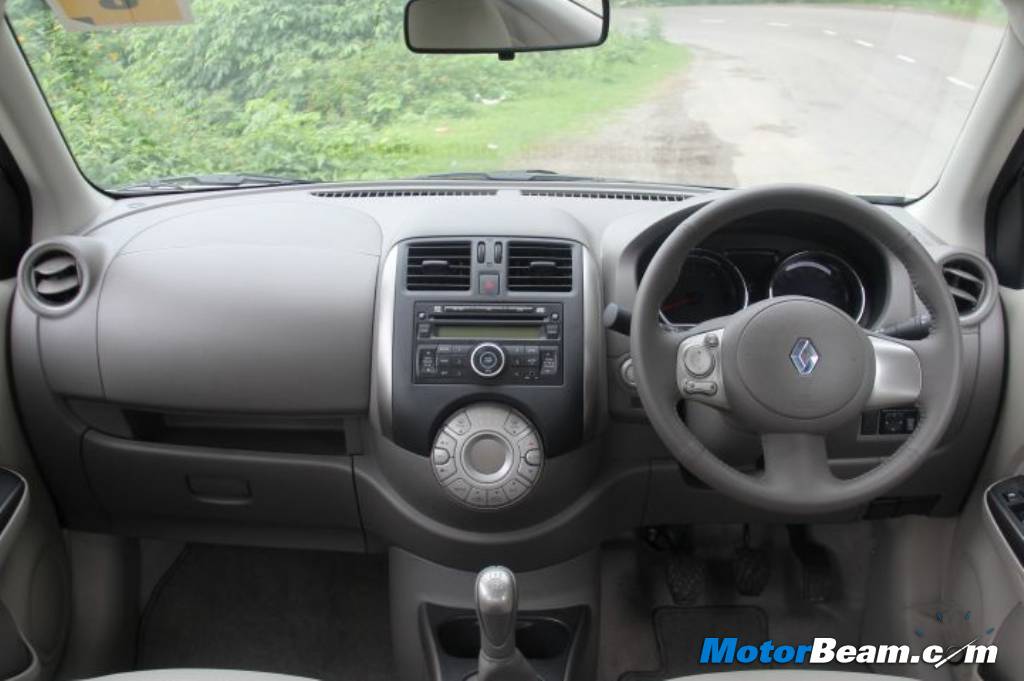
The Sunny and Scala might be siblings but their dashboards are vastly different, rear seat space is massive
The Verna and Rapid are the only cars with projector headlights with the Hyundai the only one using LEDs in the headlight. The Fiesta, Linea and City are the only cars here with cruise control, the Fiesta and Linea are the only vehicles with rain sensing wipers while the Linea, Fiesta and Verna get automatic headlights. The Linea is the only car here with ambient lighting. The Rapid and Vento have a cool feature wherein you can open and close windows from the outside of the car, using a button on the key. Leather seats are offered on the Verna, City, Sunny and Scala. Boot space wise, the Linea has the biggest trunk with the Sunny/Scala siblings finishing next followed by the City. The Fiesta has the smallest boot here. However it’s clear, the winner in the interior department is the Honda City, it has most appealing dashboard and instrument cluster, best seats and driving position along with a very roomy cabin.
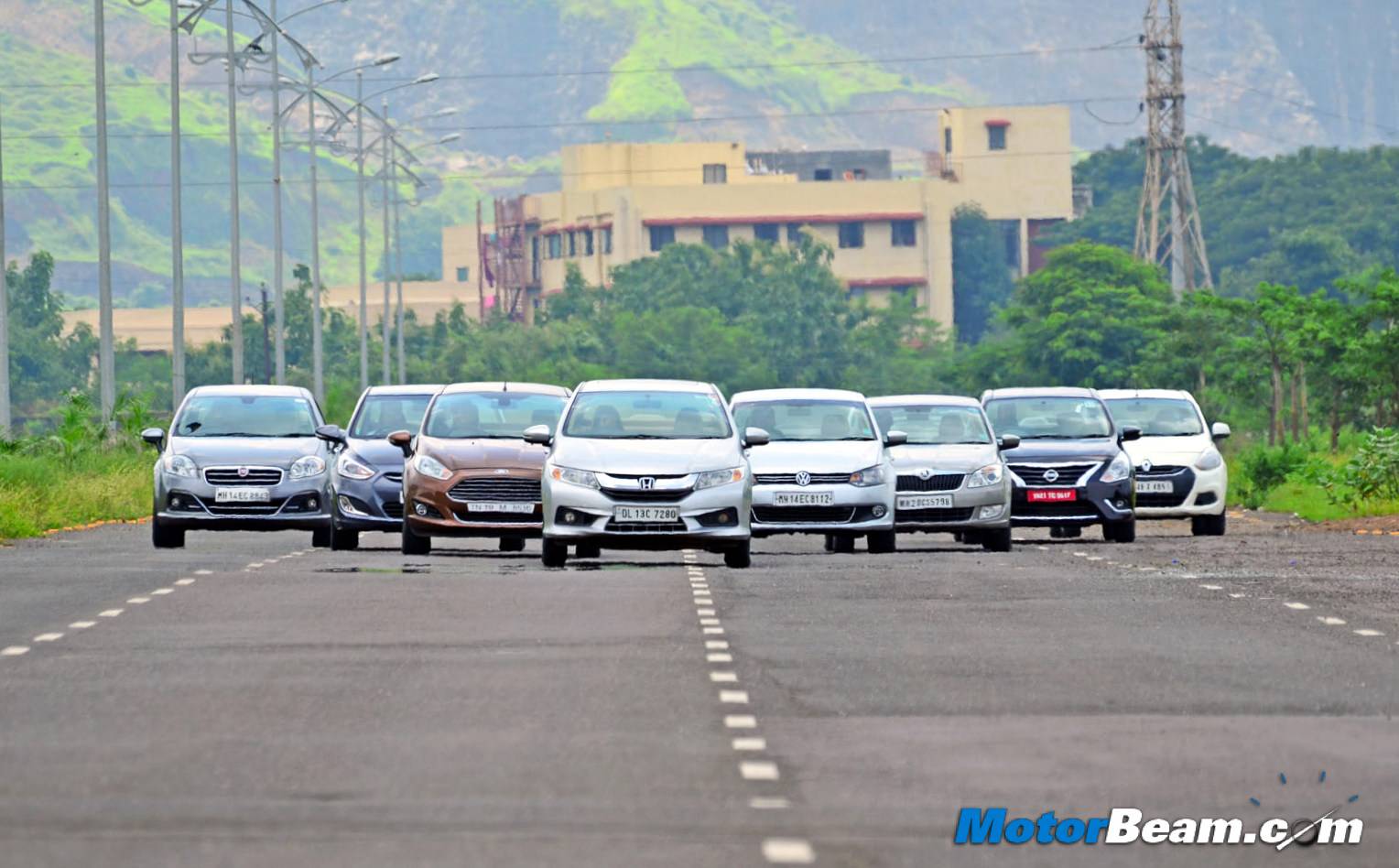
Performance – Comparing the performance of eight cars can be quite a daunting task but thankfully four cars share their powertrains, the Sunny and Scala are powered by the same engines while the Vento and Rapid largely use the same motors. Still there is some difference as the Vento also gets a 1.2 TSI engine which isn’t offered on the Rapid. The performance of all these cars can be segregated easily due to vast differences in output but let’s first discuss petrol engines. Volkswagen and Hyundai are the only companies here who offer two petrol engines, the Vento getting a 1.6-litre along with a 1.2 while the Verna coming in 1.4 and 1.6-litre options. While both engines of the Vento produce 105 PS of power, the turbocharged mill produces more torque at 175 Nm (the 1.6 produces 153 Nm) being paired to only a 7-speed DSG transmission, yes the Vento TSI is the best petrol automatic here.
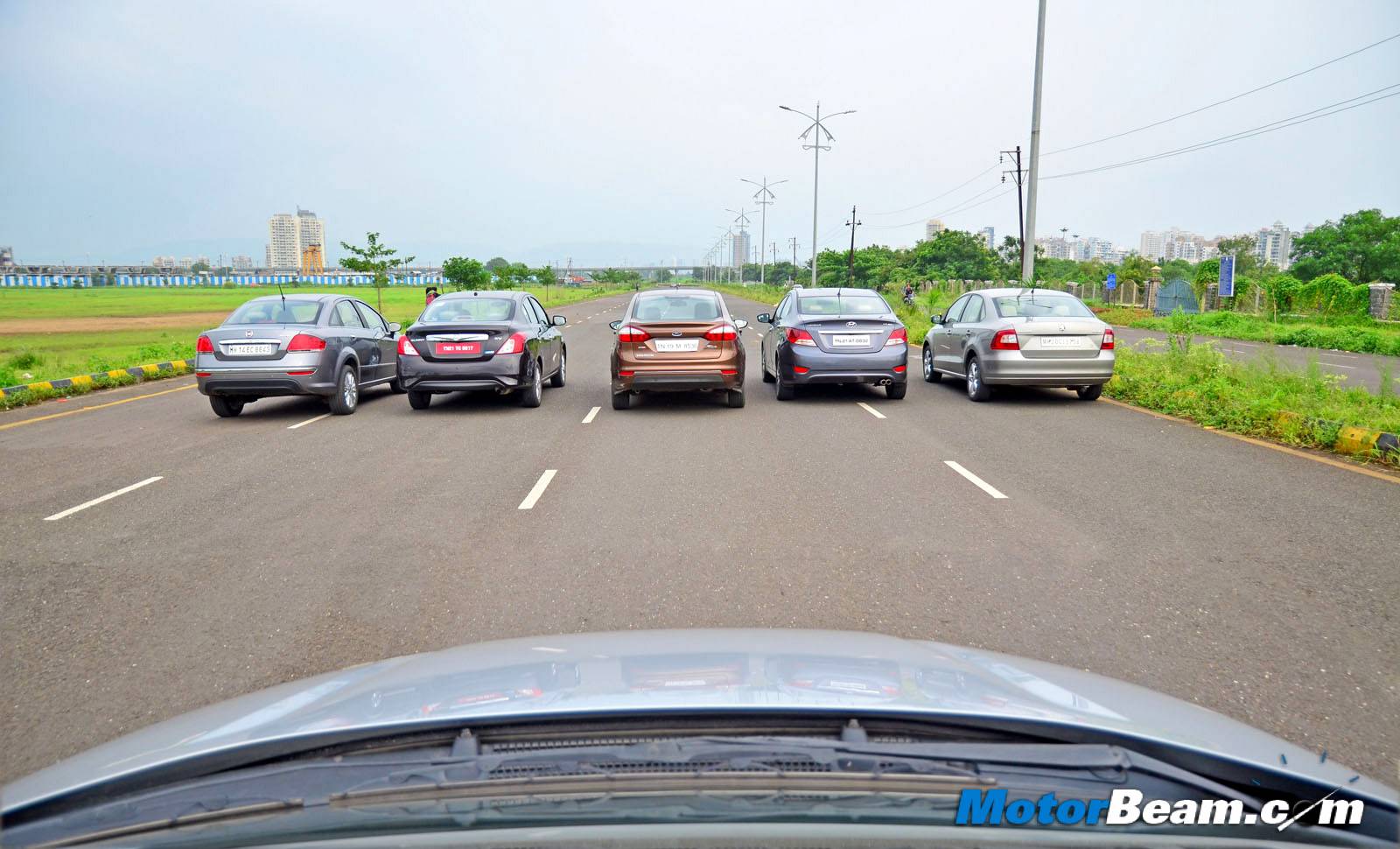
When it comes to performance, the Honda City is the petrol king while the Hyundai Verna is the diesel king
The City, Scala and Sunny are also offered with automatics, all being 7-step CVT units, the City’s being better than the X-Tronic unit. Even the Rapid and Verna (both 1.6) are offered with an autobox, Skoda using a 6-speed unit while the Hyundai gets an age old 4-speed one. While the Verna’s 1.4-litre petrol engine produces 107 PS and 136 Nm, the 1.6-litre unit is the most powerful petrol here, producing 123 PS and 158 Nm. The City is the second most powerful car here with 119 PS and 145 Nm, followed by the Linea at 114 PS. The Linea and Vento 1.2 TSI are the only cars here with a turbo-petrol engine. The 1.6-litre petrol engine in the Vento and Rapid output 105 PS while the Sunny and Scala’s 1.5-litre gasoline mill generates 99 PS (101 PS in the automatic) and 134 Nm, taking 11.87 seconds for doing 0-100 km/hr. The Fiesta isn’t offered with a petrol engine. While the Verna has the most power, the City’s i-VTEC motor is without a doubt the best petrol engine here, the Linea T-Jet following a close second.
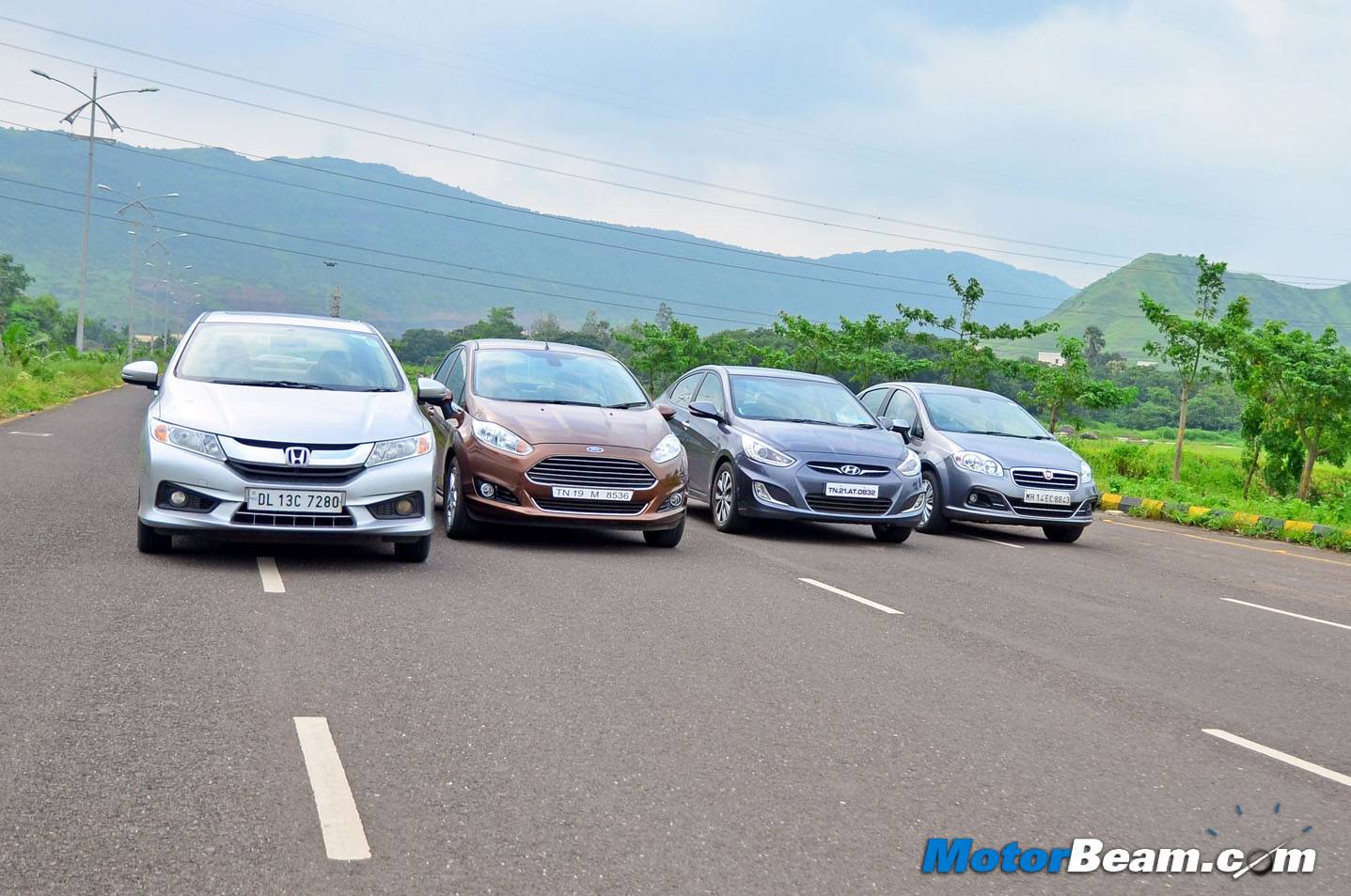
Hyundai’s engine is good too and feels responsive with a good punch when you give it the beans but it lacks the soul of the Honda and Fiat units. Driving the Linea T-Jet is addictive and 207 Nm of torque is class leading here, you simply love the turbo whistle. It has the best mid-range punch here while the best top-end honours go to the City which redlines like crazy at 7000 RPM. All cars except the Fiat Linea (and Vento 1.2 TSI) use naturally aspirated petrol engines so drivability is good in all of them but if you want to have fun while driving, the City is the unanimous pick of the lot, followed by the Linea T-Jet. Even the Vento and Rapid have a fun to drive motor while the one in the Scala and Sunny is a bit more sedate. Efficiency wise too, the City is quite strong while the Linea the least frugal owing to its heavy weight. But in spite of the weight of the Fiat, it’s quite quick, taking 10.67 seconds to do the 0-100 km/hr sprint on our VBOX, which is faster than the Vento 1.2 TSI’s 10.85 seconds but slightly slower than the City’s 9.83 seconds, the Verna does the sprint the fastest in 9.46 seconds. The City is faster till 90 km/hr but the Verna pulls ahead post that, both cars are quite neck and neck in terms of acceleration.
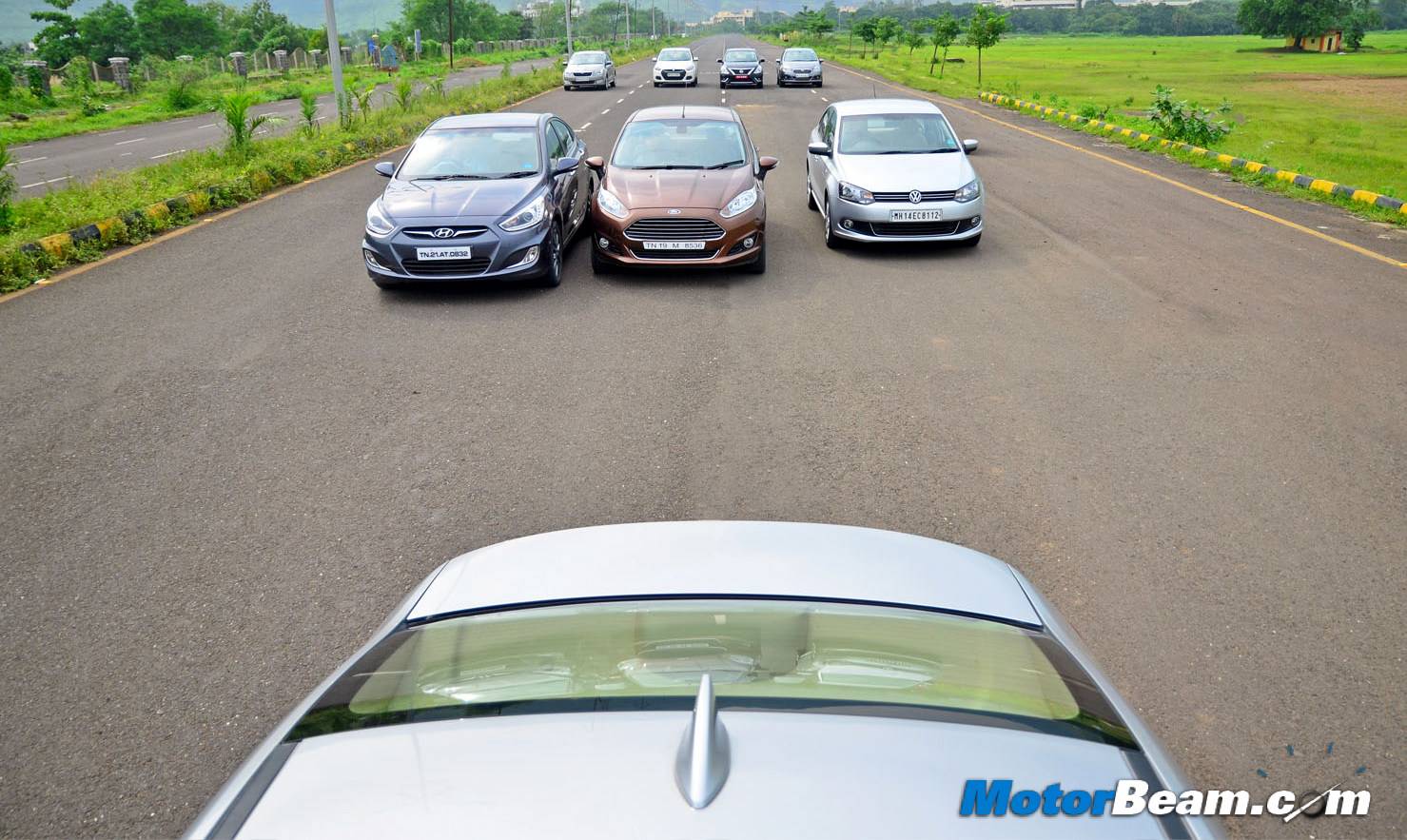
When it comes to the diesel engines, all cars come with manual transmission (the City and Verna 1.6 get a 6-speed) while the Hyundai is the only car of the bunch to be offered with an automatic in diesel guise (4-speed auto). The Verna is also offered with two diesel engines, the 1.4 produces 90 PS and 220 Nm (0-100 km/hr in 12.18 seconds) while the 1.6 is the most powerful here with 128 PS and 260 Nm, taking 10.09 seconds for the 0-100 km/hr sprint. The least powerful diesel cars here are the Scala and Sunny with 85 PS and 200 Nm (0-100 km/hr in 14.45 seconds) but they totally excel when it comes to drivability and are faster than the Linea diesel which takes 16 seconds for the sprint to 100 km/hr. While the Linea feels a bit bogged down at the low end, the Renault Nissan cars have very little turbo lag. The Linea and Fiesta both have similar output (93 PS, 209 Nm in the Fiat and 91 PS, 204 Nm in the Ford), the latter having more punch and doesn’t feel underpowered one bit, unlike the Fiat which has quite a lot of lag lower down. The Vento and Rapid both use the same 1.6-litre TDI engine which outputs 105 PS, 250 Nm and performance is really punchy, 0-100 km/hr taking just 10.15 seconds.
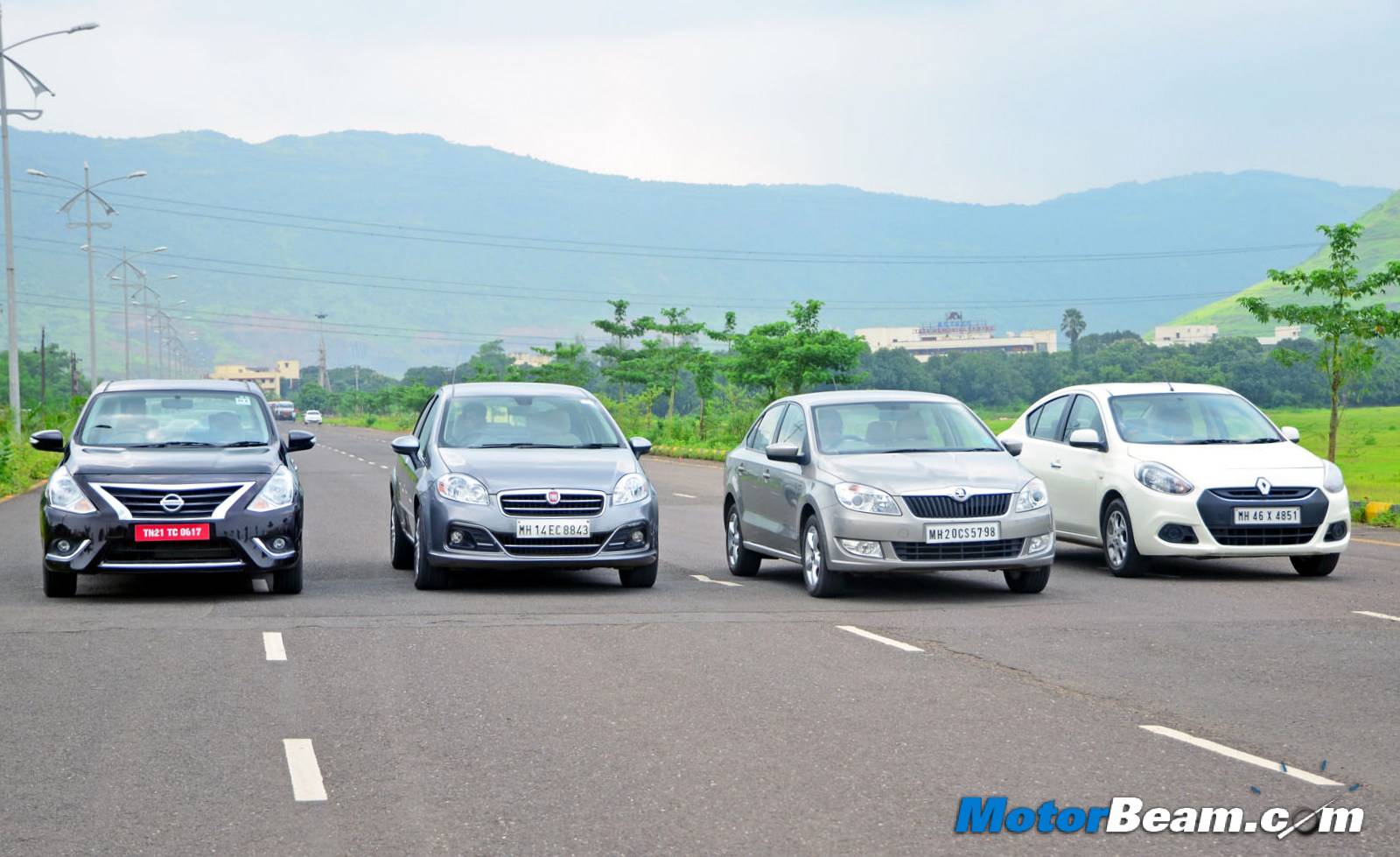
The City’s 1.5-litre diesel engine has 100 PS of power and 200 Nm of torque, the motor is noisy although drivability is excellent and so is the overall performance (0-100 km/hr in 11.97 seconds), making it good both in the city and on the highway. Still, the Verna’s horsepower lead is massive and it is without doubt the fastest car here with the most punch. The Verna is also excellent on NVH. The City is the most efficient diesel car here, followed closely by the Fiesta. The Linea is the least efficient while the Sunny, Scala and Verna beat the Vento and Rapid in terms of mileage numbers. Gearbox and clutch operation is above average on all these cars but if we had to pick a favourite, the City it would be for the petrol and Verna for the diesel.
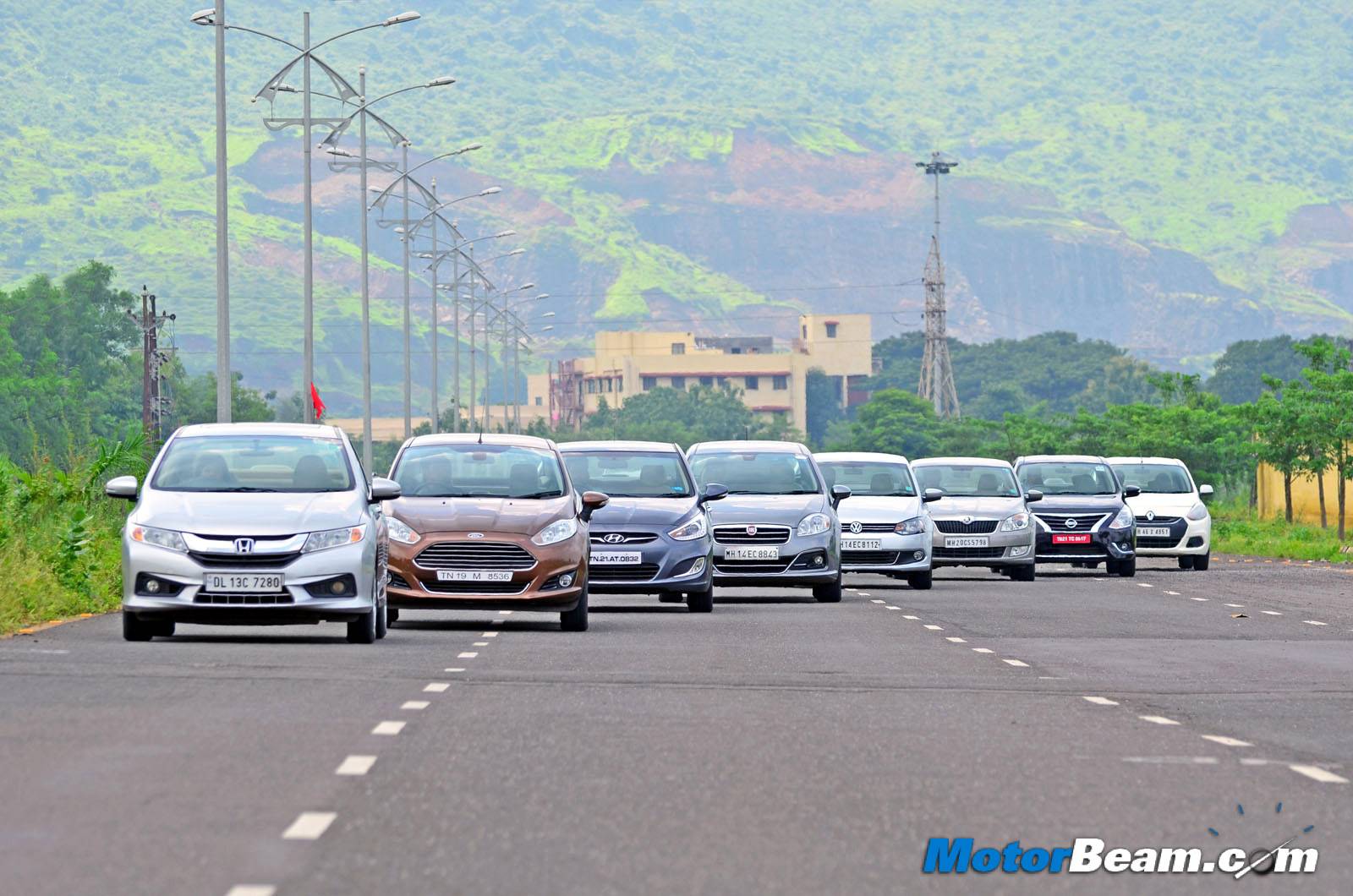
Driving Dynamics – All these eight cars can be classified into two categories – fun to drive and not fun to drive. Anyone with even half knowledge about cars knows which vehicle goes into which category. Yes, the Sunny, Scala and Verna are not the cars which will paste a big smile on your face. The other five though, have excellent handling and can really make you grin every time you corner hard. The Vento and Rapid’s good handling is only robbed away from the steering feel which is a bit lacking while the Linea is the only car here with a hydraulic steering but the high ground clearance robs it from being the best handler here, it also has the highest turning radius. The City comes a close second and with better tyres, it might be able to challenge the dynamics king, the Ford Fiesta which handles like a charm with the most precise steering of the lot.
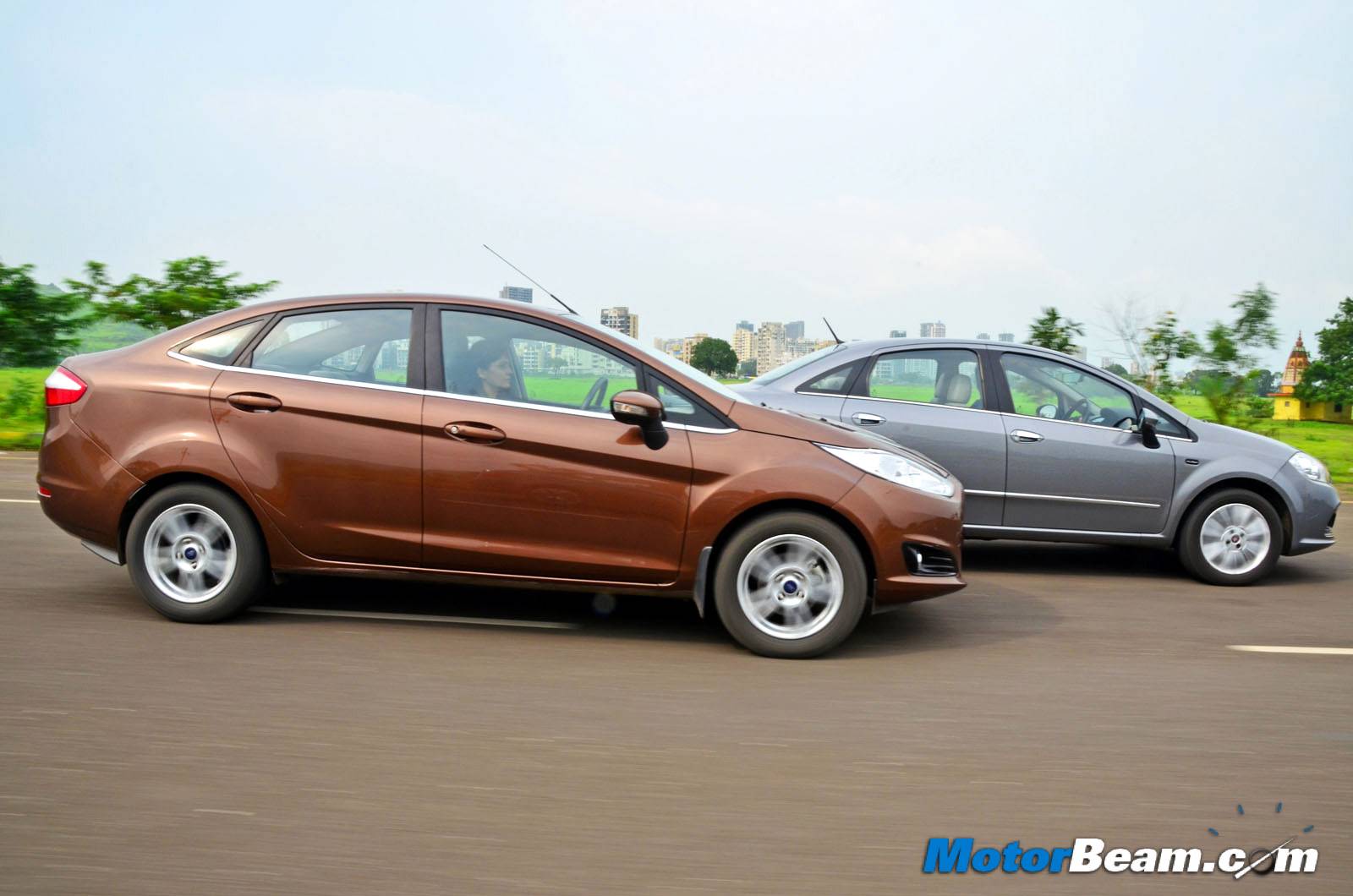
The Fiesta and Linea are very similar, both handle well, ride quality is excellent and the steering response is quite precise
Out of all these cars, the Verna feels the worst in terms of driving feel (it has improved considerably compared to the older version), it also doesn’t have good high speed manners and the ride quality isn’t even close to as good as the Linea, City and Fiesta. The Sunny and Scala have slightly softer suspensions and given their positioning as chauffeur driven cars, their handling is acceptable and the ride quality is good too. The Vento and Rapid have a good ride but the City is just better while the Fiesta and Linea finish on top in this department. Braking performance on the Fiesta is the best but again the Verna finishes last here, on heavy braking it doesn’t maintain its line. All cars do offer good brakes though. Clearly, if you are looking at driving, the Ford Fiesta is on top here followed by the Linea.
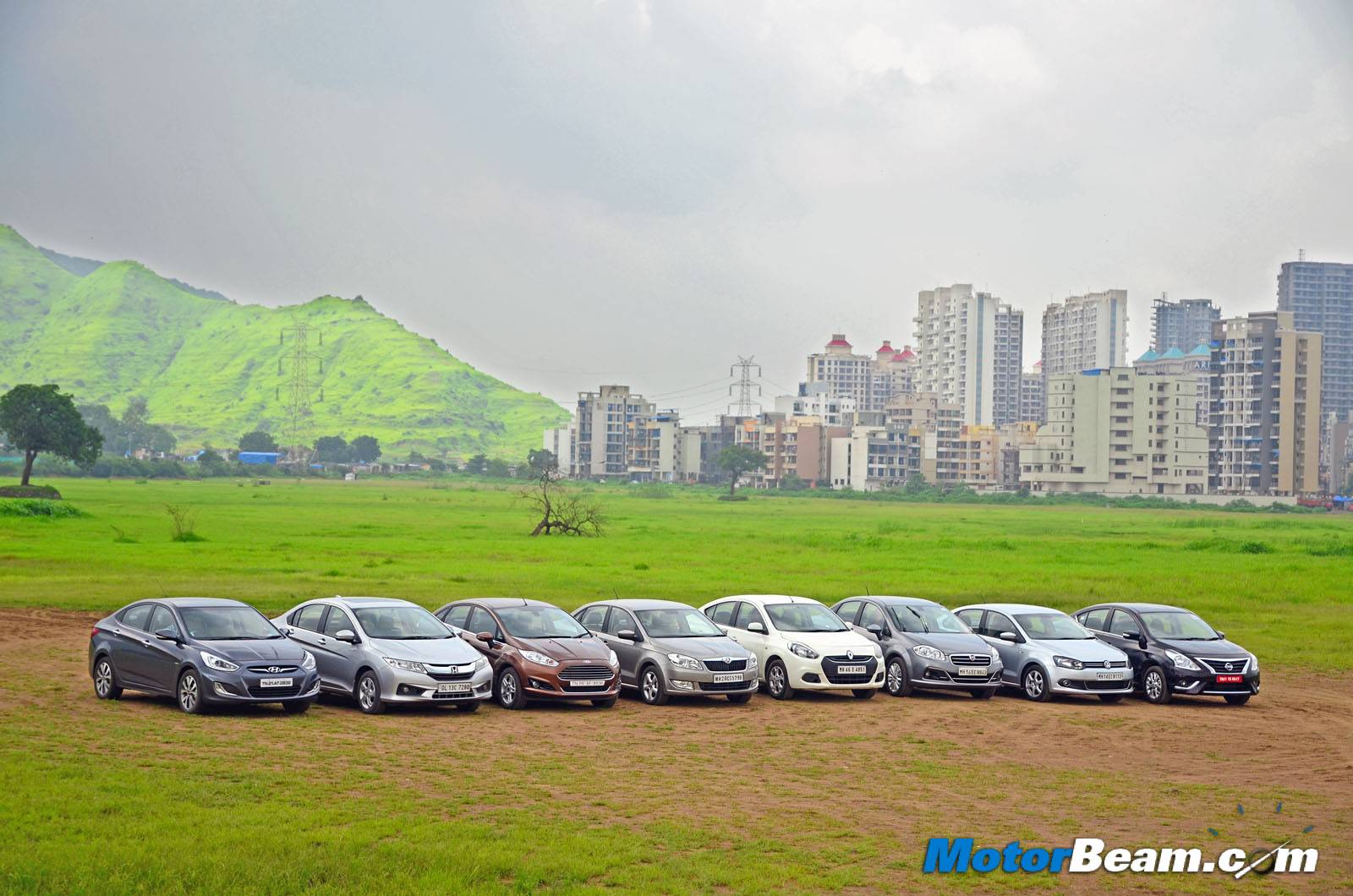
Safety and After Sales Service – Out of all these cars here, only the Fiesta, Verna (as the Accent) and Sunny are sold the world over. Cars like the Rapid and Scala are India specific while the Vento and Linea are made for emerging markets. The City is an Asia centric car. The Fiesta and Linea feel the safest here with their tank like build quality while the Verna is equipped with the most airbags (six of them on the top-spec trim) and the Sunny gets an option of four airbags. Out of all these cars, the Ford Fiesta is the only one to be tested by Euro NCAP and get 5-stars. In terms of service, Hyundai and Honda are both excellent while Volkswagen, Skoda are the worst of the lot and Nissan, Renault are just about average. Ford has already shown improvement and ranks third in service while Fiat is showing huge promise of improvement.
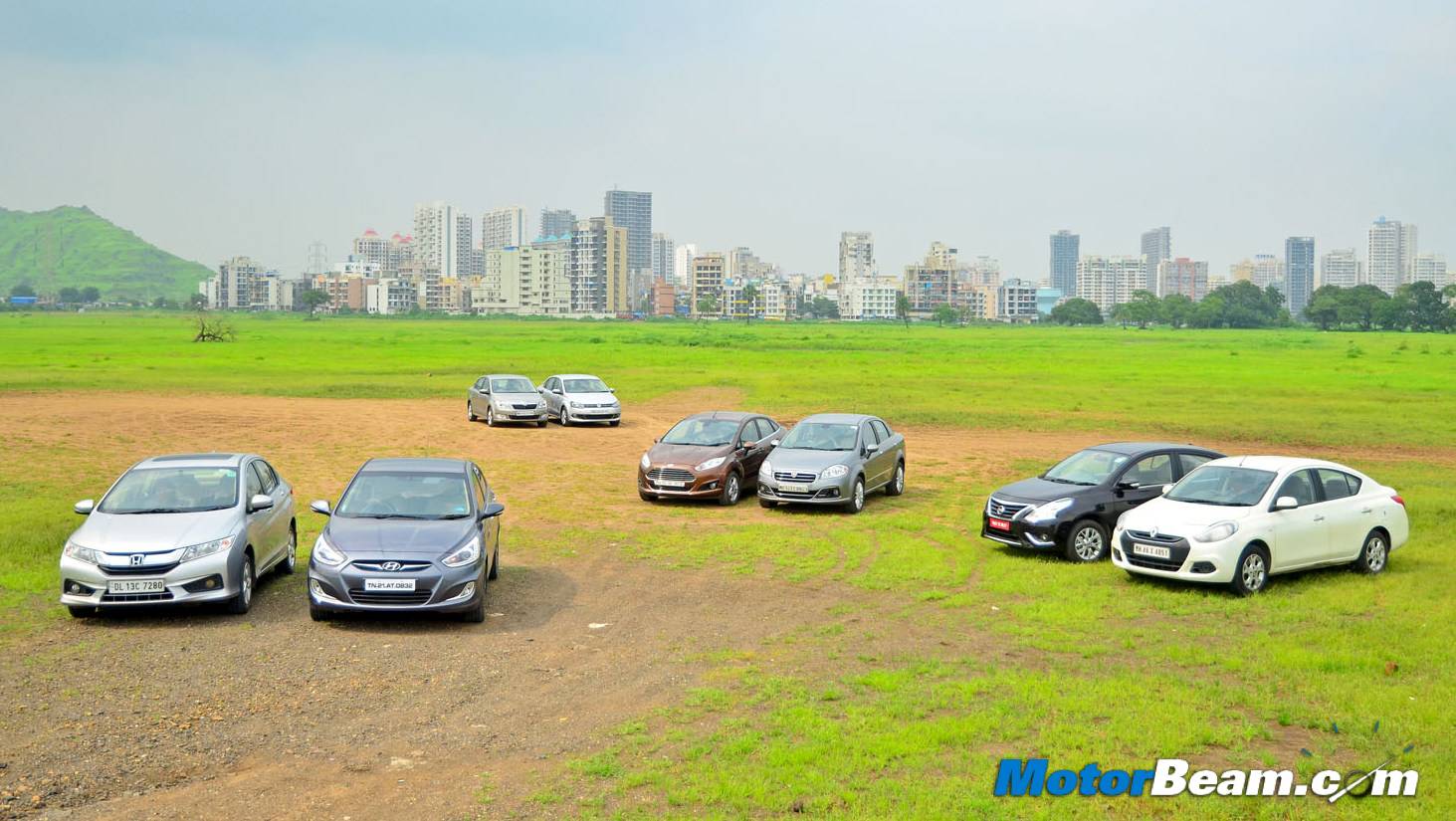
Verdict – The Renault Scala is nothing but a badge engineered Nissan Sunny, it might have been strong had the Sunny facelift not come but the updates made by Nissan make the Scala not only look old but quite pointless too as Renault continues to charge more money than the Japanese automaker, the Scala finishes last in this shootout. Finishing seventh is the Skoda Rapid, a car which is very good but feels a bit dated now and gets overshadowed by its Volkswagen sibling. The Vento finishes sixth, yet another fantastic car but lack of equipment and not standing out on anything anymore has put it behind in this test. Fifth place is secured by the Nissan Sunny, a car whose trump card of space makes it the default choice of the chauffeur driven. Coming fourth is the Linea, a rare car which appeals more to the heart than head, the Fiat’s lack of performance (in diesel guise) and lowest efficiency robbing it much appreciation.
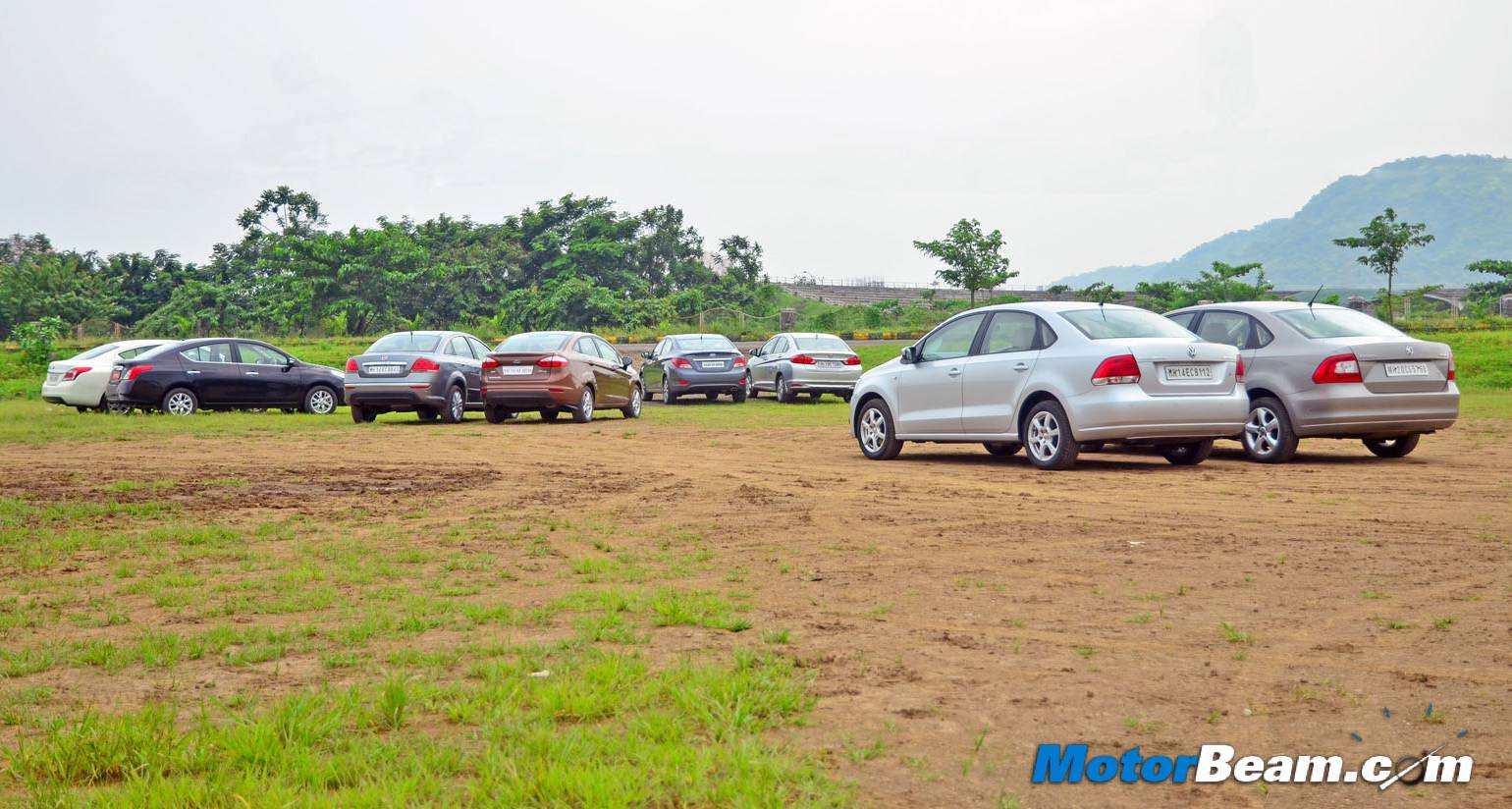
This brings us to the top three. Finishing third is the Hyundai Verna, the car with the most engine and gearbox options along with a range of variants to appeal to the majority. The Verna not being a car launched recently also means that one can get a good deal in the form of discounts and freebies while delivery will be instant too, something not available on the winner of this shootout, the Honda City which commands a big fat waiting period but is without doubt the best car of the eight here. Honda has managed to squeeze in the space of a Sunny, quality of a Verna and dynamics of the Fiesta in one brilliant package. The City is the most complete car here, it just feels a notch above most of these vehicles (after all, it’s the freshest of the lot in terms of generation). The runner up in this shootout deserves special applaud, the Ford Fiesta is almost faultless, the only thing lacking is rear seat space. Otherwise, in terms of value, nothing beats it, for instance the top-end Fiesta diesel costs Rs. 50,000/- less than the top-end City petrol, now that’s stellar bang for your buck. So if you like driving, the Ford is the only way to go, else there is absolutely no doubt that the high demand for the Honda City is purely because it is the best car in its class.
All these cars offer something significant, the Sunny and Scala have the best interior space, the Rapid and Vento have a good blend of performance and comfort, the Linea and Fiesta are the most appealing with excellent dynamics, the Verna is the most powerful with the best quality and a range of variants to suit everyone’s needs while the City excels at almost everything.
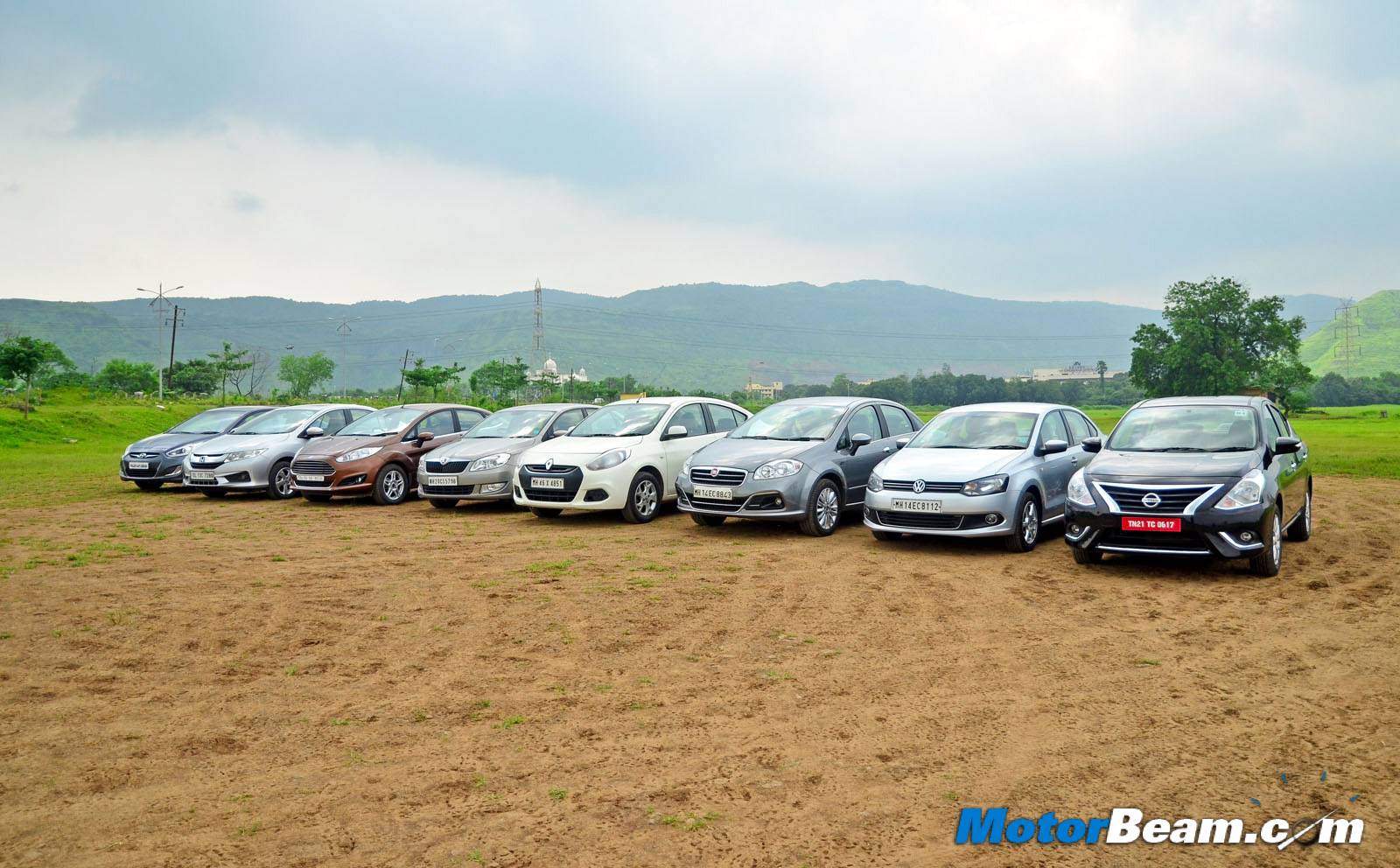
Further Reading –
2014 Honda City Review
2014 Ford Fiesta Review
2014 Hyundai Verna Review
2014 Fiat Linea Review
2014 Nissan Sunny Review
2014 Volkswagen Vento Review
2014 Skoda Rapid Review
Renault Scala Review
Maruti Ciaz Review
Hyundai Verna vs Honda City vs Volkswagen Vento
Honda City Diesel Review
Honda City Long Term Review
Honda City Long Term Report
Maruti Ciaz vs Honda City
Maruti Ciaz vs Honda City – Video
Honda City vs Volkswagen Vento AT


